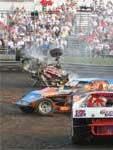
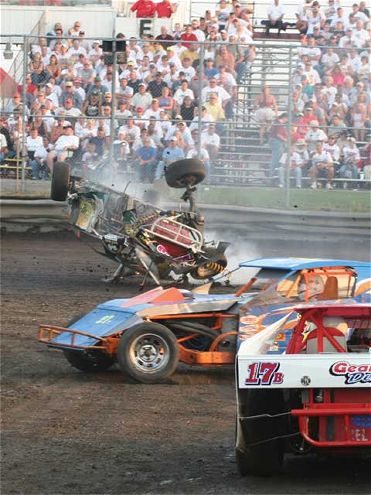 Every accident doesn't end up resulting in this type of damage, but you just never know. The driver needs to take all precautions. <i>photo by Motorsports Photography</i>
Every accident doesn't end up resulting in this type of damage, but you just never know. The driver needs to take all precautions. <i>photo by Motorsports Photography</i>
The outcome is never certain when the green flag comes down. We don't know who is going to win, how that driver will get to the front, or what is going to transpire between the start and the ending. Along the way, there could be some circumstances that loom as threatening to the driver. Those situations have no element of predictability, but there are certain steps that can be taken to help determine the outcome.
Regardless of the kind of car, class, or racing, safety must be the top consideration. The selection of the fireproof racing suit and protective helmet is a decision that is basically automatic, though there are areas where the driver could stand to be a little more knowledgeable in plenty of cases. Once you get beyond the basics, the landscape goes from black and white to gray. In many cases, if the safety section of the rule book doesn't say you have to wear it, many drivers simply won't.
The excuses for omission are many. They range from concerns of comfort to concerns of economics. The economics argument is easy to defend but just as easy to dismiss. If you aren't prepared to do it right, don't do it at all.
Safety gear is designed for the purpose of protection--often protection from one's self. The idea that "it can't happen to me" is exactly why certain smaller aspects of safety should be used. In fact, it's the reason any aspect of safety should be selected.
As the '06 racing season unfolds, the latest innovations will be on display. Helmets have been carrying the latest Snell certification (starting October 1, 2005), and the idea of using one that was certified for racing in 1995 will no longer be acceptable in most cases (Those with the Snell 2000 standard generally remain acceptable). It forces a driver to buy a helmet every 10 years at a minimum, but helmet purchases should be far more frequent than that.
The helmet is one part of an overall safety package, and the smart racer thinks of safety as a grouping, not a collection of individual items with priority rankings. A protective item doesn't have to cost hundreds to work, but not having it can cost thousands.
Start at the Bottom
photo from Crow Enterprises">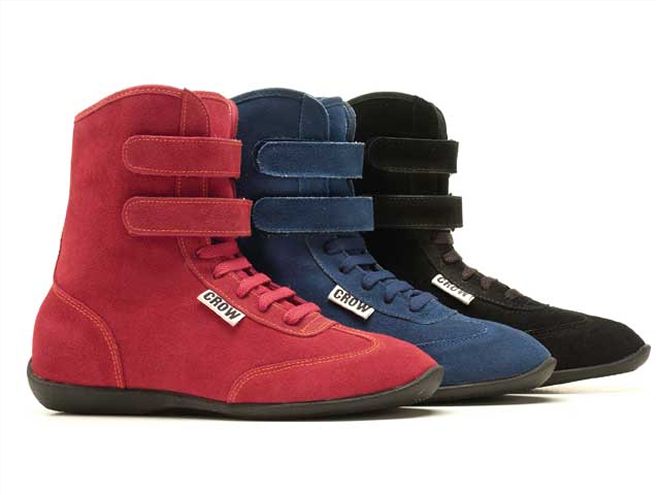 Style and comfort play a role, but protecting the feet is the key consideration of a good racing shoe. <i> photo from Crow Enterprises</i>
Style and comfort play a role, but protecting the feet is the key consideration of a good racing shoe. <i> photo from Crow Enterprises</i>
While there is a strong increase in the use of the protective racing shoe, it is still an afterthought to many racers, simply because the rule book doesn't say "must." The manufacturers of the modern racing shoe have done their homework. There is plenty of thought put into the product being offered, and safety remains the central focus of that thought.
"The shoe selection rests with the driver," says Debbie Bishop of Simpson Race Products. "We make shoes for all types of racing, and that's what the driver needs to look at. For example, we offer a shoe that is all leather, and then there's a style that is suede and leather. The leather is easier to clean at dirt tracks, which makes it popular with Sprint racers."
"We offer the mid-top or the high-top shoe, which is an issue of style," says Jeremy Curtis ofG-Force Racing Gear. "There has to be consideration of the foot space in the car."
"Our shoes are pretty basic," offers John Crow of Crow Enterprizes. "Comfort is the number-one consideration after safety. They are all manufactured to be protective. From that point, it becomes driver preference as to the style. The size of the footbox has a lot to do with it. For example, Formula guys, with their heel-and-toe style of driving, need a shoe like a mid-top so that it doesn't restrict ankle movement."
The use of materials such as fleece Nomex offers the protection inside the boot while the outer layers are designed to protect from heat and flame. Shoes are also designed with the thought of pedal feel, as non-slip soles allow the driver to keep control of the pedals without fear of slipping off the brake or accelerator.
photo from G-Force Racing Gear">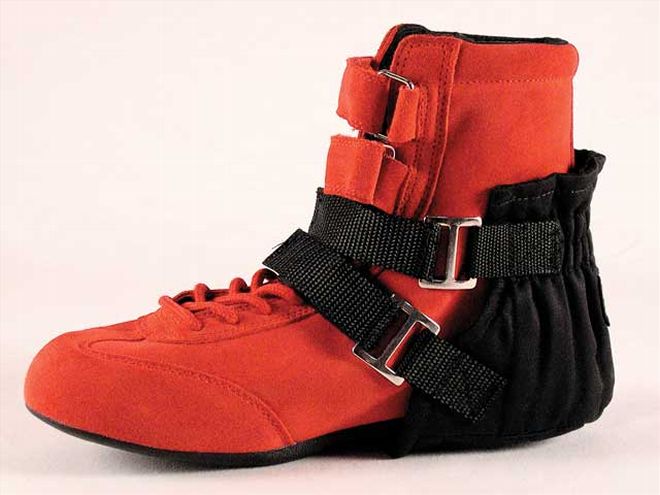 Extra protection for the heel can be realized with heel boots such as these offered by G-Force. <i>photo from G-Force Racing Gear</i>
Extra protection for the heel can be realized with heel boots such as these offered by G-Force. <i>photo from G-Force Racing Gear</i>
The footbox is likely one of the hottest places in the cockpit under normal conditions. Under less than normal conditions, its proximity to the engine can turn the area from footbox to oven in a hurry. For this reason, some shoes are designed with additional protection in the heel area. If your shoes aren't, there are added steps you can take.
"We offer a heel boot that's popular with many," added Curtis. "It's a Nomex shield that slips onto the shoe. A lot of drivers wear them on just the right foot, but there are those who will use them for right and left. They're made from Nomex inside and out and are very protective."
While there is plenty of thought given to the design of the shoe itself, there can be no detail left to chance. For this reason, Simpson has made Nomex laces available on its Fusion shoe and made it an upgrade for any shoe sold.
While the companies take steps to keep the cost of items like shoes in the "affordable" range, the consideration should start with protection, followed by comfort. Style, while important, should be low on the priority list. Fortunately, unlike sports such as bowling, the idea of a gaudy specialized shoe is unwelcome. The protective shoe is generally stylish and appealing and a natural fit to a racing ensemble.
Handwork
photo from G-Force Racing Gear">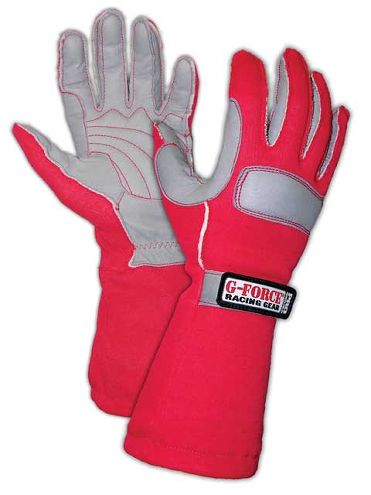 The days of barehanded racers should be long gone. Gloves are designed to give the driver solid feel and grip to do the job. <i>photo from G-Force Racing Gear</i>
The days of barehanded racers should be long gone. Gloves are designed to give the driver solid feel and grip to do the job. <i>photo from G-Force Racing Gear</i>
It wasn't that long ago that in-car cameras found drivers of major-league stock cars sawing on the wheel in their bare hands. Not anymore. You won't find that picture without a penalty of some sort these days, and wisely so.
The hands hold more than a steering wheel in our lives. For most, the same hands that grip the wheel are also the hands that are used during the week in the course of doing the job that brings food to the table and extra income to buy parts for the race car. Protecting your hands means protecting your future.
"When we look at a glove style, we consider natural fit and curvature as part of the design process," says Bishop. "We want to develop a product that molds easily to the grip of the hand. It's a driver preference when it comes to gloves. All drivers are not going to like all gloves. The decision is made on the feel and the material."
"It's safety first and comfort next," adds Crow. "Our Wings gloves have an SFI 5 rating. They have two layers of Nomex, and the palm area has one layer of Nomex. If you have a lot of material in a glove, it's hard to get the comfort because the material will bunch up. I put on every pair of gloves. I wear a large, so some are too small and some are too large, but I look them over and make sure the threads are right. A glove is the type of thing that you put on and decide. If it feels good, you'll buy it. If not, you'll ask what else is available."
"Gloves have gotten better now than they were a few years ago," says Curtis. "It's a better product, and it's being offered at a point where the average racer can easily afford them. We have our Pro RS model, which features reverse seams for greater protection and comfort by being stitched externally. The Pro 5 has an SFI 5 rating for protection."
SFI Rating
On a couple of occasions, we've made reference to an "SFI rating," so there needs to be an explanation of that.
The SFI Foundation, based in California, offers standards for performance automotive and racing equipment, which provide guidelines for manufacturers. Adhering to SFI standards is required by some sanctioning bodies, who use the SFI watermark as the determination for safety acceptance.
SFI started out as a division of the Specialty Equipment Market Association (SEMA). Now completely separate from SEMA, the SFI Foundation is a non-profit organization. Programs are funded by participating manufacturers who pay for development and administration of programs through license fees or provide grants and donations.
"The SFI certification adds credibility to the product," says Curtis. "They make sure that everyone is meeting the same specification. When it's Company A against Company B, you know that they're going to be close to the same with their own twists but still within the SFI standard. Then, for the buyer, it becomes a matter of cost versus quality."
"They lay down the rules and we meet or exceed them," said Crow. "It helps us to make our products the best they can be. If something doesn't measure up, we take it back and make it better."
"It's a tough process," says Bishop. "There's a lot of time and expense involved, but it helps get the products recognized. If you can meet or exceed the standards, you are protecting the drivers. That's what we want to do."
The manufacturer's involvement is voluntary, but the sanctions help force the issue to keep substandard equipment from entering the market. SFI encourages industry-wide participation in the drafting of specifications.
Arm Protection
photo by Mike Horne">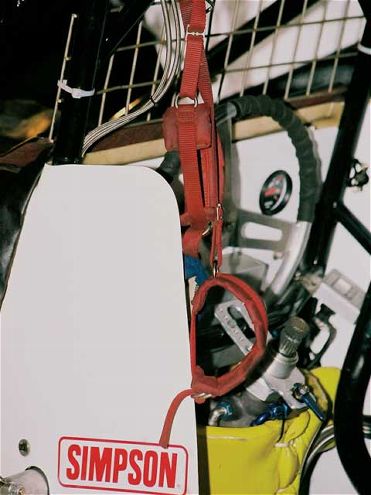 This racer keeps the arm restraints right by the office. When the time comes to strap in, this critical piece for this Sprint Car racer is ready for action. <i>photo by Mike Horne</i>
This racer keeps the arm restraints right by the office. When the time comes to strap in, this critical piece for this Sprint Car racer is ready for action. <i>photo by Mike Horne</i>
It's almost a no-brainer for open-wheel racers, but it doesn't come without some resistance. The use of arm restraints is a good idea for many other forms of racing as well. There have been many pictures of old-time racers where the arms of the drivers were seen flailing outside the cockpit. Serious arm injuries can result in many cases, and taking protecting steps to prevent that is the right choice.
"Our arm restraints are simple to operate, and that helps the user understand how it works and why it works," says Chris Adams of M&R Products. "The Velcro cuff and one-point release are some of the aspects of these models. We have some users who prefer offset lengths."
This safety feature is one that should benefit from its presence in junior racing. Quarter Midgets, Karts, and Junior Dragsters are among those who use arm restraints.
photo from Crow Enterprises">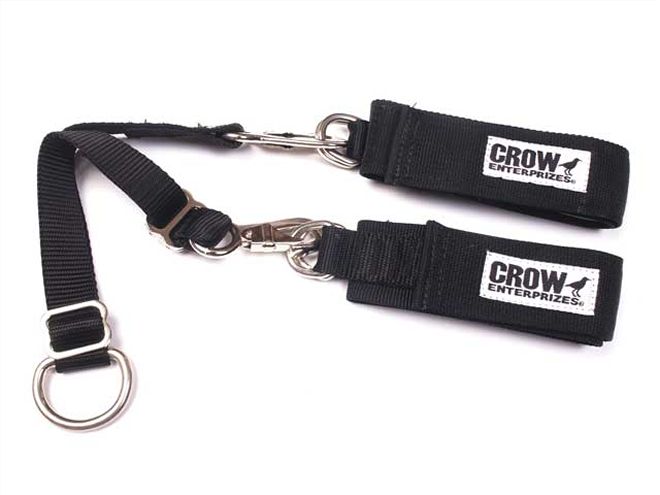 Arm restraints are popular items for young racers. They learn to use the gear and carry that knowledge through their racing.<i> photo from Crow Enterprises</i>
Arm restraints are popular items for young racers. They learn to use the gear and carry that knowledge through their racing.<i> photo from Crow Enterprises</i>
"We need to teach them from the ground up," says Adams. "You want to make sure it's safe. It's your child out there. If you teach them safety now, they will carry it throughout their racing, even throughout their regular driving. They will want their street car to be safe and secure."
"You want the racer to become familiar with the equipment," says Curtis. "The earlier they start using them, the better it will be. It's especially important in youth racing."
There are different types of arm restraints available, but proper use is the key element. Some drivers have been known to wear them on the wrong part of the arm, so following the manufacturer's directions is critical in making certain the best protection is being offered.
Save Your Neck
photo from M&R Products">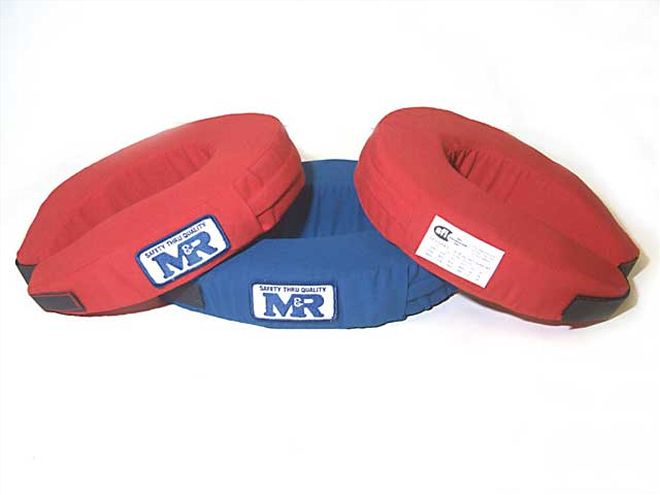 The simple neck collar still has a prominent place in racing. Make sure it is properly worn before taking the green. <i>photo from M&R Products</a>
The simple neck collar still has a prominent place in racing. Make sure it is properly worn before taking the green. <i>photo from M&R Products</a>
While many of the top sanctions are implementing the head-and-neck restraint devices, short-track weekly racers still view it as an expense that is too great, especially because it is not mandatory. There is a reasonable alternative that provides neck protection, and it's the simple neck collar. While a neck collar alone cannot provide the level of protection of the head-and-neck units, it's an option that a racer must entertain.
"A neck collar can work really well with some of the systems that are based on straps that attach to the helmet," says Adams. "The neck collar has to be properly fitted. To hear the driver say, `I can't move my head,' is kinda the point behind it. You want to have little movement to keep the neck stable."
Out of Body
photo from M&R Products">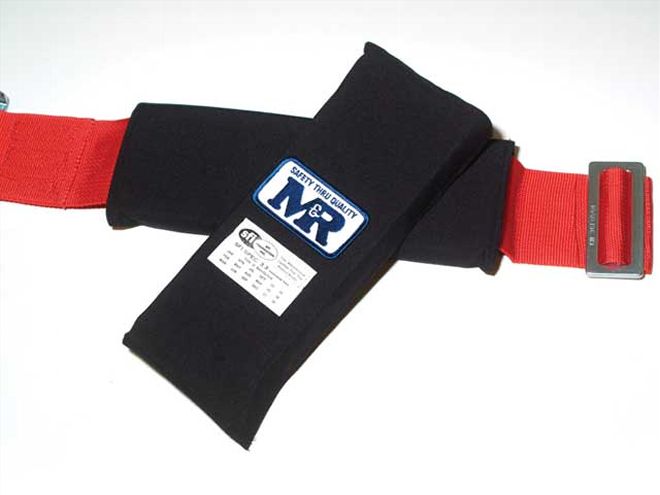 Shoulder padding on the belts can ease some of the effects on impact. <i>photo from M&R Products</a>
Shoulder padding on the belts can ease some of the effects on impact. <i>photo from M&R Products</a>
Protection doesn't stop at the tips of the fingers and toes. There are plenty of steps that can be taken with safety equipment that can help keep the driver safe in the event of the unwanted accident.
As part of the car, items such as window nets, heat-resistant padding, rollbar padding, and shoulder belt padding are some of the steps being taken.
One product that is sure to catch on is the reverse-stitch shift boot cover that uses Simpson's CarbonX and Kevlar materials. The Kevlar lining reduces heat transfer. The reverse stitching keeps the unit intact as fire comes at it through the transmission tunnel beneath the vehicle. This allows the driver precious additional seconds to exit the car before flames enter the cockpit.
Rollbar padding is perhaps the most inexpensive insurance against driver injury. The simple padding, placed strategically, will lessen head, arm, or leg impact with 'cage components or other areas where the body parts shouldn't be.
Thermal barrier protection can be used to keep the driver from the distraction of excessive heat and protect the feet. It can also serve as a barrier to fire.
photo from M&R Products">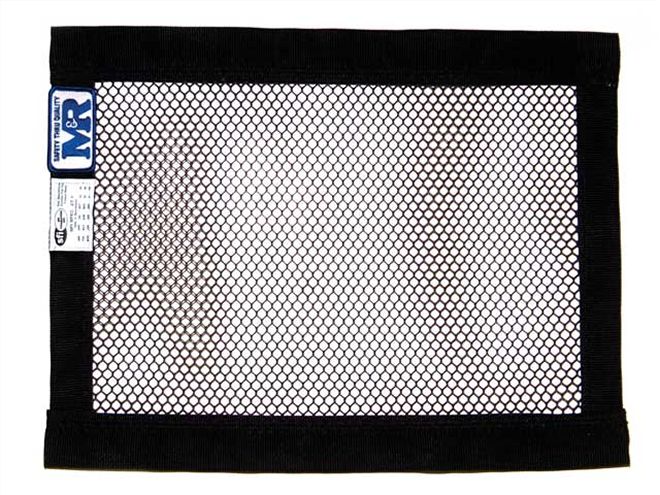 There are different types of window nets that do the job for safety. The mesh style...<i>photo from M&R Products</a>
There are different types of window nets that do the job for safety. The mesh style...<i>photo from M&R Products</a>
More sanctions are starting to address the use of window nets. For 2005, the IMCA mandated the use of window nets in all divisions. Many still use the word "recommended" if making reference to window nets.
There are different styles of window nets, and nets are subject to SFI standard 27.1. Most top companies who manufacture the nets have participated in the standard.
The advantage to a window net is obvious. It keeps material from entering the cockpit and striking the driver. With that thought in mind, some drivers use not only a left-side net, but have also installed a triangular window net on the right side of the car.
photo from M&R Products">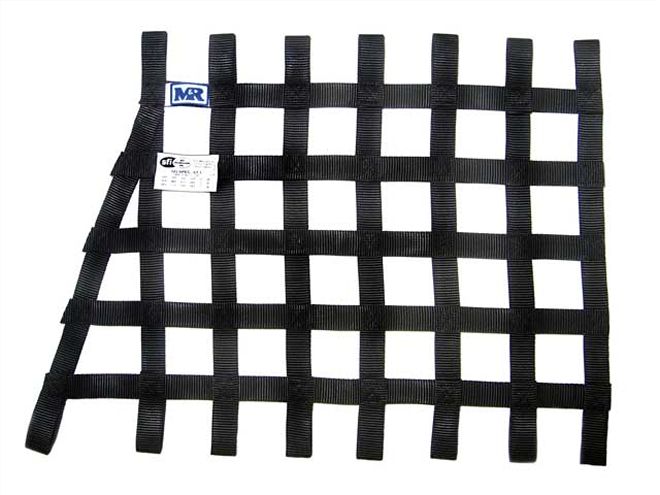 ... ribbon style...<i>photo from M&R Products</a>
... ribbon style...<i>photo from M&R Products</a>
"Window nets are a great idea," says Crow, who is a racer. "There are more classes that have eyes outside the driver, so the argument of not being able to see isn't valid.
"We custom-make our nets. We don't do the mesh style. We only do the 1-inch ribbon, and they pass the SFI certification. The size of the net depends on the car and the seat being used. Some seats have bigger headrests. The triangular nets start at 10 inches wide and work down to 2 inches wide. They use a quick lever release for easy removal."
photo from M&R Products">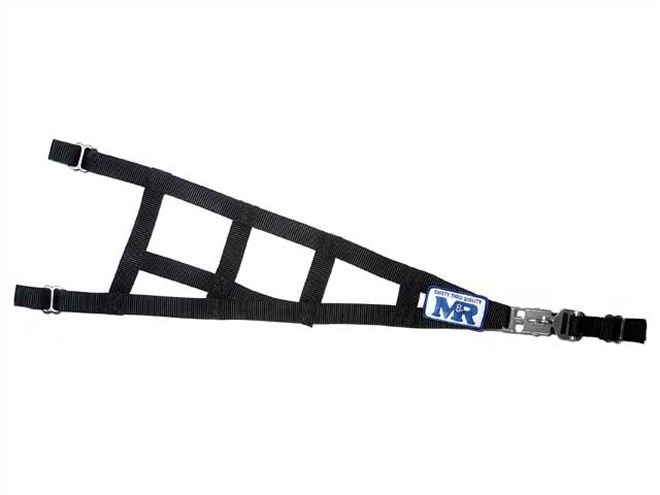 ...and triangular style can be used in tandem or singularly, depending upon your application. <i>photo from M&R Products</a>
...and triangular style can be used in tandem or singularly, depending upon your application. <i>photo from M&R Products</a>
Crow says the nets have to be strong to get the SFI acceptance. "You can drop a 25-pound sandbag on it from 4 to 5 feet and it will hold."
The choice of style and material is usually a decision made by the driver. "We offer the mesh style and the ribbon style," says Adams. "We make as many custom nets as we do regular nets. We have a variety of installation rods, so there's something for everybody in window nets."
The Whole Picture
There is really no such thing as too safe. The inherent danger of the sport means that something can go wrong, but controlling the number of possibilities is the goal of the smart racer.
"These items aren't expensive when you look at it," says Adams. "A custom window net is maybe $40. That's not a lot of dollars, and it's certainly worth it to protect your arms and head. A neck collar is $30, and arm restraints are $30. A lot of fathers who were racers don't want their kids to take those unnecessary risks. They may realize they were lucky and don't want to take the chance."
"Having the safety gear is important, but making sure they use it properly is the key," says Bishop.
"Be ready," adds Crow. "You never know what's coming, but you can be prepared to deal with it."
And, you have to remember life beyond racing. "With racing, there could be permanent injury," Adams says. "It may be a minor injury, but it could be a permanent one as well. Pay attention to the detail. All of the safety equipment needs to work in conjunction with the rest of it. If it's not there, it can't do it. Each element alone can only do so much. Once you put it all together, you have the best chance."